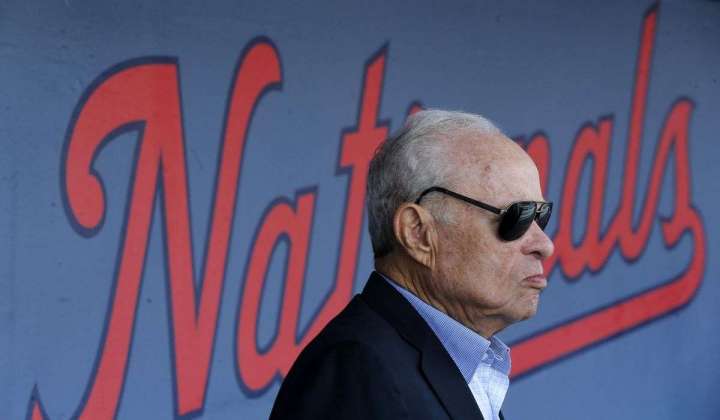LOVERRO: Lerner’s Nationals legacy is a dollop of misery with a dash of World Series glory

The Washington Nationals will open the season Thursday honoring their late owner, Ted Lerner, by inducting him into the Ring of Honor before the game against the Atlanta Braves
They’ll put his name in the Ring of Honor, right below the owner’s suite at Nationals Park. There will also be a patch on the sleeves of their home and away jerseys — TNL, Ted Lerner’s initials — to commemorate the man who passed away on Feb. 12 at the age of 97.
Under his ownership, the Nationals won a World Series championship — the first one in this city in nearly 100 years — and that is certainly an achievement worth celebrating. Like players often say, ‘Once you’ve won a championship, no one can take it away from you.’ It is, in some ways, sports immortality.
But once Thursday’s ceremonies are over, the Nationals and their $80 million witness-protection roster face 39 games against the Braves, Phillies and Mets — three National League East Division rivals with payrolls that dwarf that of the Nationals.
The results of those mismatches, when it’s all said and done at the end of this season, will be part of Lerner’s legacy as well.
Yes, he won a title, but Lerner also will be remembered for running Washington’s baseball team like one of the shopping malls that made him rich.
Don’t be surprised if Nationals Park later this summer resembles the since-demolished Landover Mall in its declining days.
I never understood how Lerner spent decades pursuing a sports franchise — he tried to buy the Baltimore Orioles in 1979 and was a bidder for the Washington Redskins in 1999 — and then, when Major League Baseball awarded the family the Nationals in 2006, he ran the franchise like it was a tax write-off.
I know they spent on talent on the field during the eight-year run of winning that led to four Nationals NL East division titles and the World Series championship. But for someone who was hailed as a business visionary, he never seemed to understand the importance of establishing a foundation among a fan base that had been without baseball for 34 years.
The Nationals in their 18th season are still a young franchise.
There hasn’t been enough time for the generations of fans to take root that any franchise needs to stay strong in down years.
Supposedly, it was the plan to lose early and often to get the high draft picks — the first-rounders like Stephen Strasburg and Bryce Harper — to build the roster. That plan actually was Scott Boras’ plan, the agent who targeted the Nationals owner early as his latest savings and loan.
It worked, based on the winning results from 2012 to 2019. But they paid a price for it. They squandered a surprising first season with a competitive team that wound up 81-81 and drew 2.7 million fans. They inherited that team in 2006 and spent the next five years driving fans away, at an important time when they needed to build up that base.
Lerner, a native Washingtonian who should have known better, never seemed to either care or understand they needed to aggressively market a sports team in a city where the football team was at the time still a huge, dominant local presence.
They opened up Nationals Park in 2008 and lost 102 games, drawing just 2.3 million fans. Like a high-ranking baseball official told me, “No one has a plan where they open up a new ballpark and lose 100 games.”
The organization, during its stretch of winning, did consistently draw 2.5 million to Nationals Park. But in their championship season of 2019, the Nationals drew just 2.26 million fans.
Then COVID-19 hit, something that nobody could have been prepared for. The Nationals were hit particularly hard, missing the chance to capitalize on the business side on their World Series title.
Since then, it’s been one losing season after another, with the worst coming last season, a 55-107 mark. They barely made the 2 million mark, and now are trying to sell the future based on the numerous prospects — many of whom remain in the minor leagues — general manager Mike Rizzo was able to acquire in the dismantling of the franchise that sent Max Scherzer, Trea Turner and Juan Soto packing.
The Lerner family has checked out, save for Thursday’s ceremony honoring the memory of their patriarch. Their efforts to sell the team have stalled because of the MASN television dispute that may not get resolved until the Orioles — essentially MASN — are sold. That won’t happen until the Orioles’ incapacitated patriarch, 93-year-old Peter Angelos, passes away.
Who knows what will be left of this Nationals franchise by the time that happens?
This season in Washington going to be a hard sell to a fan base that is still in its adolescent years, especially for an organization that never understood how to sell or cared enough about it even in its good years.
It doesn’t have to be that hard.
There is no reason why the Nationals, with a little more spending on payroll this season — as was the case in the early Lerner years — couldn’t have fielded a more competitive team while still accomplishing the goal of developing younger players. I know it is the strategy the front office wanted to pursue.
Instead, they have chosen to field a team consisting of cast-offs, last-chance opportunities and some young, promising talent — with a bottom-feeding payroll.
Open the gates.
⦁ Hear Thom Loverro on The Kevin Sheehan Show podcast.






